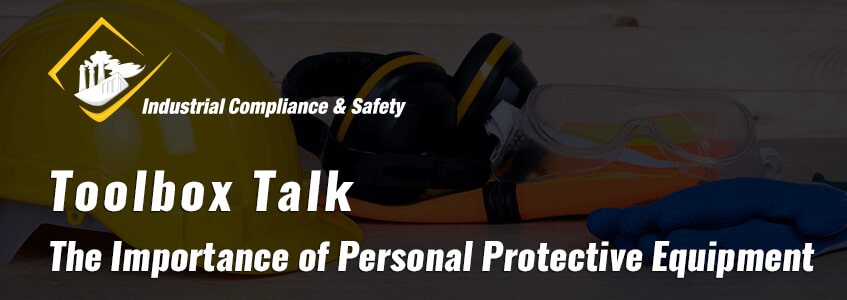Date: ____________________________________
Supervisor: _______________________________
Company Name: _____________________________
Job Name: ______________________________
Personal protective equipment (PPE), such as safety goggles or steel-toe boots, are standard in any contractor worksite. Because contractors work with a wide array of tools and materials, they need special equipment to protect them from various hazards. Although PPE may be introduced when workers are learning safe operating procedures in their initial training, this can fall to the wayside once workers are more comfortable working onsite. It may seem like a hassle to find and wear protective eyewear when performing a quick soldering job, or it may seem like a hassle to find and put on gloves when lifting a wooden pallet. However, accidents occur when they are least expected, and proper PPE presents a formidable barrier between safety and harm.
Guidelines for Discussion
If you were taught to complete a task with personal protective equipment during your initial safety training, then always use the same personal protective equipment when completing the task. You never reach a point of competency where you are immune to accidents or danger. Even if you think you could complete a task while blindfolded with both hands tied behind your back, there are still surrounding factors - factors outside of your control - that can harm you. Consider the following case studies:
- Rob was a pipefitter with nearly 15 years of experience under his belt. One day, he was assigned the mundane task of unloading pipes from a boom truck. Though he had performed this task countless times during his career, he still put on his hardhat. Rob was standing on the truck when one of the straps securing the pipes got caught in his clothing. As he reached for the strap to secure it, the entire strap came loose. Rob lost his footing and fell backwards off the truck. He landed head-first on the concrete. His coworkers rushed to his side, fearing the worst. However, because Rob was wearing his hardhat, he suffered only a mild concussion.
- Nick was a steam fitter working on a high line. He was only three scaffold tiers off the ground (roughly 20 feet). Although he’d been working on the same scaffold for nearly a month, Nick followed company procedure and attached his fall-protection system. While he was welding a joint, the pumps below the scaffold started up. The force jostled the entire scaffold and knocked his supporting pick boards loose. Nick fell through the scaffold, but he was saved by his fall-protection system. If Nick wasn’t wearing his PPE, he could have broken a leg and missed work for weeks.
- Alex was cutting reclaimed wood to make pallets. The day before, she had inspected and prepped the wood by sanding it and removing old nails. After powering on the chop saw, she remembered her training and put on a pair of safety glasses. When cutting one of the planks, the saw sputtered and fragments of metal came flying from the wood: she had missed a nail during her previous inspection. Luckily, her safety glasses protected her from what could have been a severe eye injury.
In all of the above examples, personal protective equipment was the only barrier between safety and harm. The incidents and hazards had nothing to do with the employees’ skill level. Had Rob, Nick, and Alex assumed that they were competent enough to work without PPE, they would have been injured. Their injuries could have caused them time away from work, reduced pay, and weeks of rehabilitation. Though it may seem like a hassle, personal protective equipment is always worth the extra time it takes to put it on.
Additional Discussion Notes:
At the end of this talk, review some rules of PPE that are specific to your company. This can include a rundown of the most common PPE in your industry, and when it is mandatory to wear it.
Safety Recommendations: _____________________
Job Specific Topics: ___________________________
Attendees:
____________________________________
____________________________________
____________________________________
____________________________________
____________________________________
____________________________________
____________________________________
____________________________________
____________________________________
____________________________________
____________________________________
____________________________________
____________________________________
____________________________________
____________________________________
____________________________________
____________________________________
____________________________________
____________________________________
____________________________________
____________________________________
____________________________________
Disclaimer
The information contained within this document (both the online and downloadable version) is provided for informational purposes only. Nobody shall take this as a comprehensive or exhaustive resource on this topic. This material is believed to be accurate, however, the information has been compiled from multiple sources, and so Industrial Compliance & Safety assumes no responsibility for the accuracy of this information. We encourage you to consult experts about this specific Toolbox Talk to ensure you are compliant with any and all safety regulations and processes. In no event does the content of this document supersede any applicable local, state, or federal statutes or regulations.





